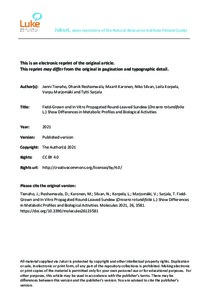Field-Grown and In Vitro Propagated Round-Leaved Sundew (Drosera rotundifolia L.) Show Differences in Metabolic Profiles and Biological Activities
Tienaho, Jenni; Reshamwala, Dhanik; Karonen, Maarit; Silvan, Niko; Korpela, Leila; Marjomäki, Varpu; Sarjala, Tytti (2021)
Tienaho, Jenni
Reshamwala, Dhanik
Karonen, Maarit
Silvan, Niko
Korpela, Leila
Marjomäki, Varpu
Sarjala, Tytti
Julkaisusarja
Molecules
Volyymi
26
Numero
12
Sivut
16 p.
MDPI
2021
Julkaisun pysyvä osoite on
http://urn.fi/URN:NBN:fi-fe2021062940371
http://urn.fi/URN:NBN:fi-fe2021062940371
Tiivistelmä
Drosera rotundifolia L. is a carnivorous plant used in traditional medicine for its therapeutic properties. Because of its small size, its collection in nature is laborious and different cultivationmethods have been studied to ensure availability. However, only a few studies exist where the lab-grown sundew tissue and field-grown sundew would have been compared in their functionality or metabolic profiles. In this study, the antioxidant and antiviral activities of lab-grown and field-grown sundew extracts and their metabolic profiles are examined. The effect of drying methods on the chromatographic profile of the extracts is also shown. Antioxidant activity was significantly higher (5–6 times) in field-grown sundew but antiviral activity against enterovirus strains coxsackievirus A9 and B3 was similar in higher extract concentrations (cell viability ca. 90%). Metabolic profiles showed that the majority of the identified compounds were the same but field-grown sundew contained higher numbers and amounts of secondary metabolites. Freeze-drying, herbal dryer, and oven or room temperature drying of the extract significantly decreased the metabolite content from −72% up to −100%. Freezing was the best option to preserve the metabolic composition of the sundewextract. In conclusion, when accurately handled, the lab-grown sundew possesses promising antiviral properties, but the secondary metabolite content needs to be higher for it to be considered as a good alternative for the field-grown sundew.
Collections
- Julkaisut [87110]
